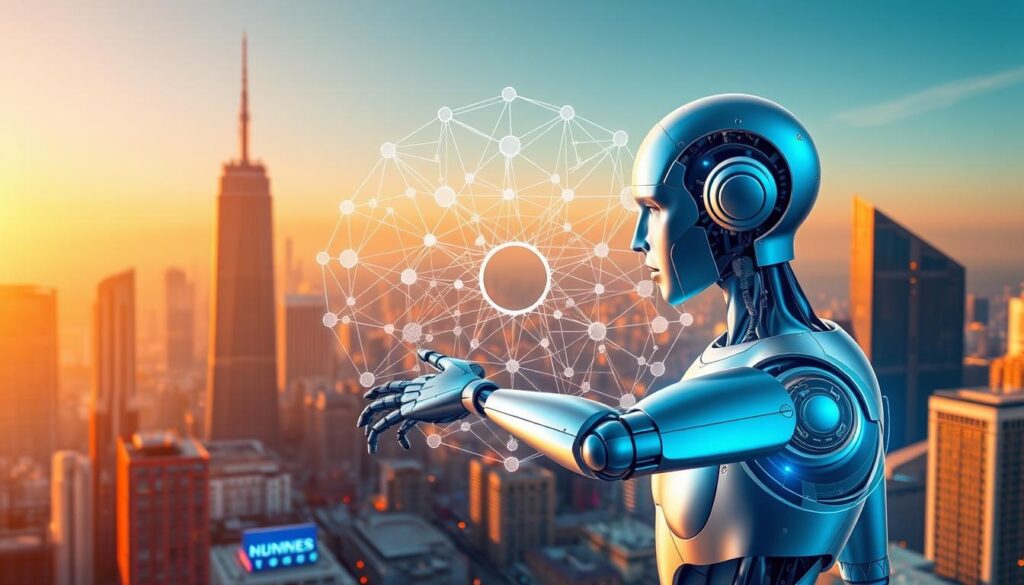Are you curious about how machines can simulate human intelligence and perform tasks with ease? Artificial intelligence (AI) is changing how we live and work. Learning about AI basics can open new doors for you.
Starting our AI journey, it’s key to understand artificial intelligence and its uses. AI is making a big impact, from better customer service to improving healthcare. It’s changing industries and shaping our future.
Key Takeaways
- Understanding the basics of artificial intelligence
- Exploring AI applications in various industries
- Learning how AI is changing the way we live and work
- Discovering the importance of AI in today’s world
- Getting started with AI as a beginner
What is AI: Understanding Artificial Intelligence Basics
Artificial Intelligence (AI) is changing our world. But what is it really? At its heart, AI is about making computers do things that humans do, like seeing, talking, and making choices.
Defining Artificial Intelligence in Simple Terms
AI uses special algorithms and models to let machines learn from data. This lets them get better at tasks over time. It’s this ability to learn and adapt that makes AI different from regular programming.
AI has many uses, from virtual assistants like Siri and Alexa to important systems in healthcare and finance. Some key AI features include:
- Machine learning
- Natural language processing
- Computer vision
The Evolution of AI Through History
The idea of AI started in the 1950s. But it has grown a lot over the years. Early AI was simple and not very capable. But with better computers and storage, AI has gotten much smarter.
Now, AI helps with things like self-driving cars and medical tests. The growth of AI shows how much humans can achieve by trying to make machines think and act like us.
As AI keeps getting better, it’s important to understand its basics. Knowing what AI is and how it works helps us see its power to change our world.
The Building Blocks of Artificial Intelligence
To understand AI, we must look at its basic parts. Artificial Intelligence relies on two main things: data and algorithms. Together, they help AI systems do complex tasks.
Data: The Fuel for AI Systems
Data is key to AI, giving it the info it needs to learn and interact. The quality and amount of data affect how well an AI works. For example, machine learning models use lots of data to spot patterns and predict things.
Algorithms: The Decision-Making Processes
Algorithms tell AI systems how to use data, make choices, and find insights. These rules help AI systems get better over time. The right algorithm depends on the task and the data it uses.
In short, knowing what makes up AI is key to seeing its strengths and weaknesses. By understanding data and algorithms, we can use AI to innovate and solve big problems.
How AI Works: A Beginner’s Explanation
To understand how AI works, we need to see how data moves through an AI system. It starts with input and ends with output. AI systems handle lots of data, find patterns, and make smart choices based on that.
Input, Processing, and Output in AI Systems
The journey starts with input, where data goes into the AI system. This data can be text, images, or sound. Then, the AI uses complex algorithms to analyze and understand the data.
The last step is output, where the AI gives a result. This could be a decision, a prediction, or even new content like text or images.
The Role of Pattern Recognition
A key part of AI is finding patterns in the data. By spotting these patterns, AI learns and gets better over time. Pattern recognition is key for many AI tasks, like recognizing images and speech, and predicting outcomes.
From Simple Rules to Complex Decisions
AI makes complex decisions by combining simple rules. Through machine learning, AI can look at huge datasets, find patterns, and make choices that humans can’t match in speed or accuracy.
Learning the basics of AI, like input, processing, output, and pattern recognition, helps beginners understand AI. This knowledge is important for seeing what AI can do and what it can’t.
Artificial Intelligence vs. Human Intelligence
AI has made huge strides, but it’s different from human smarts. Human brains can do many things, like solve problems and feel emotions.
Similarities and Differences
AI and humans can both handle data well. But AI is faster and more precise for certain jobs. Humans, on the other hand, are better at understanding complex situations.
AI solves problems with algorithms and data. Humans use their life experiences, gut feelings, and emotional smarts.
Current Limitations of AI
AI is getting better, but it’s not perfect. It has trouble with things like sarcasm, jokes, and subtle feelings.
| Aspect | AI | Human Intelligence |
|---|---|---|
| Data Processing | Fast and Accurate | Flexible and Contextual |
| Problem-Solving | Algorithm-based | Experience and Intuition-based |
Machine Learning: The Engine Behind Modern AI
At the heart of modern AI is machine learning. It lets systems get better over time. Machine learning is key for machines to learn from data. It’s a vital part of artificial intelligence.
How Machines Learn from Data
Machine learning trains algorithms on data. This lets them spot patterns and make choices. It’s key for AI to do complex tasks.
By learning from data, machines get better and more efficient. They can do things more accurately over time.
Types of Machine Learning Approaches
There are many machine learning ways, each with its own uses. Knowing these is key to using machine learning well.
Supervised Learning
Supervised learning uses labeled data. The right answer is already there. It’s great for tasks like classifying images and understanding speech.
Unsupervised Learning
In unsupervised learning, data without labels is used. The model finds patterns itself. It’s good for grouping similar things and finding odd ones out.
Reinforcement Learning
Reinforcement learning lets models learn by trying things and getting feedback. It’s used in robotics and playing games.
Knowing and using these machine learning types helps make AI smarter. It can learn and adapt in many ways.
Artificial Intelligence and Machine Learning: Understanding the Relationship
Artificial intelligence and machine learning are often confused with each other. But they have different meanings that beginners need to understand. Knowing how AI and ML relate helps us see what each field does and how they work together.
How ML Fits Within the Broader AI Field
Machine learning is a part of artificial intelligence. It deals with creating algorithms and models that let machines learn from data. This is key for AI to get better over time without needing to be told how.
Key aspects of ML within AI include:
- Data-driven decision-making
- Pattern recognition and prediction
- Continuous improvement through learning
Why This Distinction Matters for Beginners
For newcomers to AI and ML, knowing their connection is very helpful. It shows how ML adds to AI’s abilities. This understanding also helps us see what’s possible now and what might come next in these fields.
| Aspect | Artificial Intelligence (AI) | Machine Learning (ML) |
|---|---|---|
| Definition | Broader field that includes many ways to make machines smart like humans. | Subset of AI that focuses on algorithms for learning from data. |
| Scope | Includes ML, rule-based systems, and more. | Primarily concerned with developing models that learn from data. |
| Applications | Virtual assistants, expert systems, robotics, etc. | Image and speech recognition, predictive analytics, etc. |

What is Generative AI: Creating Instead of Analyzing
Generative AI is a big change in artificial intelligence. It focuses on making new things, like text, images, and music. This is different from old AI that just looked at data. Now, AI can create new content, which opens up new ways to be creative and innovative.
Text Generation: From Chatbots to Content Creation
Text Generation: From Chatbots to Content Creation
Generative AI is really good at making text. It can make chatbots talk like humans, write articles, and even send emails. This has changed how we talk to machines and make content.
Image and Video Generation
AI is also getting better at making images and videos. It can create new ones or change old ones. This is useful in movies, ads, and virtual reality. For example, GANs make images that look very real and are used in many fields.
Music and Audio Generation
AI is also making music and sounds. It can create songs or even whole soundtracks. This is changing the music world, where AI music can be used in videos and playlists. As “AI is not just a tool, it’s a collaborator”, experts say.
As AI gets better, it will change many industries. It will help us create new things and interact with digital media in new ways. Generative AI is set to change how we make and use digital content.
AI in Everyday Life: Applications You Already Use
Artificial Intelligence (AI) is now a big part of our daily lives. We often don’t even notice it. It makes our devices better and changes how we use online services and smart homes.
AI in Smartphones and Personal Devices
Our smartphones show AI in action. Virtual assistants like Siri and Google Assistant understand and answer our questions. They also help take better photos and guess what we’re typing.
AI in Online Services and Social Media
Online services and social media use AI to make our experiences better. For example, Netflix suggests movies based on what we’ve watched. Social media platforms use AI to show us posts and people we might like.
AI in Smart Home Technology
AI is making our homes smarter. Devices like Amazon Echo and Google Home control lights, temperature, and entertainment. They learn what we like, making our homes more comfortable.

As AI gets better, it will play an even bigger role in our lives. It will become a key part of how we use technology every day.
Getting Started with AI Tools for Beginners
The world of AI is getting easier to enter, thanks to tools made for beginners. These tools help newbies learn AI basics without needing to know a lot of tech.
No-Code AI Platforms
No-code AI platforms let users make and use AI models without coding. Tools like Google’s AutoML and Microsoft’s Power Apps have easy-to-use interfaces. They’re great for beginners who want to try AI without coding headaches.
AI Assistants and Chatbots
AI assistants and chatbots are big in our daily lives. Tools like Amazon’s Lex help developers make chatbots. They’re also good for learning about natural language processing (NLP), a key AI topic.
Simple AI Creation Tools
Simple AI tools, like Teachable Machine by Google, make creating AI models easy. They’re perfect for learning and for those who want to try AI development.
As Andrew Ng said, “AI is like electricity. It will change many industries like electricity did.” With these tools, starting your AI journey is fun and easy.
“The best way to get started is to quit talking and begin doing.”
Using these tools, beginners can start their AI adventure. They can experiment and learn by doing.
Beginning Your AI Study Journey
Starting your AI study requires the right tools and a plan. You’ll find many ways to learn AI as you begin.
Free Online Resources for Learning AI
Many websites offer free tutorials and guides for learning AI. Sites like Coursera, edX, and Khan Academy have great courses on AI and machine learning. Also, blogs and YouTube channels focused on AI are great online resources.
Structured Courses for Different Learning Styles
If you like a structured course, there are many options. Udemy and DataCamp have detailed courses on AI and data science. These courses fit different learning styles, helping you find the right one.
Building Projects to Reinforce Learning
Building projects help you understand AI better. Start with simple tasks like chatbots or image classification. Then, move to more complex projects. This hands-on learning will make your knowledge stronger and prepare you for real-world uses.
Conclusion: Your Path Forward in the AI World
The field of AI is changing fast, and keeping up is key. The ai future looks bright, with new discoveries in generative AI and machine learning.
To keep moving forward, stay current with AI news. Use free online tools, courses, and projects to learn more about AI.
This way, you’ll be ready for the future of AI. You’ll understand how AI can help you in your life and work. This will help you make smart choices about AI’s role in your future.
FAQ
What is Artificial Intelligence (AI)?
Artificial Intelligence is about making computers do things that humans do. This includes learning, solving problems, and making decisions.
How does AI work?
AI uses algorithms and data to let machines learn and make decisions. It gets better over time.
What is the difference between AI and Machine Learning (ML)?
AI is a wide field that includes many techniques, like ML. ML focuses on teaching machines to learn from data.
What is Generative AI?
Generative AI can create new content like text, images, and music. It does this by learning from existing data.
What are some common applications of AI in everyday life?
AI is used in many ways. It helps with virtual assistants, image recognition, and understanding natural language. It also does predictive analytics.
How can I get started with AI?
Start by learning the basics of AI and ML. Look for online courses and try out AI tools and platforms.
What are some popular AI tools for beginners?
Beginners can use no-code AI platforms, AI assistants, and simple tools for creating AI.
What is Deep Learning?
Deep Learning is a part of ML. It uses neural networks to analyze complex data.
What are the benefits and risks of AI?
AI brings benefits like better efficiency and decision-making. But, it also has risks like job loss, bias, and security issues.
How is AI used in business and healthcare?
In business, AI helps with customer service and predicting trends. In healthcare, it aids in diagnosing diseases and personalizing treatments.
What is Natural Language Processing (NLP)?
NLP is a part of AI that deals with computers understanding human language. It’s used for translation and analyzing feelings in text.
What is Computer Vision?
Computer Vision is a part of AI that deals with understanding visual data. It’s used for object detection and facial recognition.




